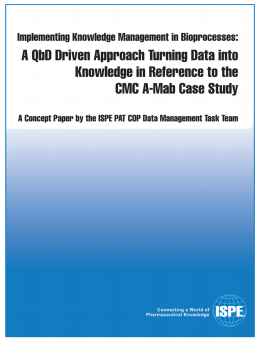Implementing Knowledge Management in Bioprocesses
1 Background and Purpose
1.1 Team Composition
The authors are members of the ISPE global PAT COP Data Management Task Team. The mission of the Team is:
- To help process developers, manufacturers, suppliers, organizations, and authorities determine how data fromprocesses can be efficiently managed so that all parameters which are relevant and critical to QbD or PAT areavailable for knowledge management and continuous improvement.
- To act as a team for consulting and advising on the application of existing standards and the development of new standards.
1.2 Drivers, Gaps, and Benefits
In January 2011, the US FDA released the revised validation guideline [2] in which an increase in the use of PAT tools is recommended and a more scientific approach is required. “Sound Science,” as required by the US FDA, suggests gaining more knowledge about the process, which requires more information and leads to more data needed. In the PAT COP, there is strong belief that the impact of data management concepts and the effort of translation data into information and knowledge are underestimated.
The huge amount of data which is generated during the process has to be translated into information and knowledge. A simple example from daily life which can illustrate the difference between data, information, and knowledge is given below:
Humans have found ways to translate data into information.
Based on “prior knowledge,” the color of a banana (information) can be used to determine its sweetness or sugar content (knowledge) (Figure 1.1). Since we know from “prior knowledge” that green bananas do not taste as sweet, it is usually better to buy bananas that are more yellow.
However, the information is not helpful unless it matches with the objective. The color of the bananas is time dependent information, and knowledge tells us that the green color will turn to yellow over time. If we need the bananas for tonight’s garden party, we should pick the yellow ones; if we want to take them for a trip and eat them later, the green ones might be the better choice.
Conclusion: Knowledge is using information to make decisions based on objectives.
Read more by downloading Implementing Knowledge Management in Bioprocesses: A QbD Driven Approach (Published: March 2012).
